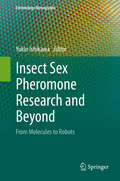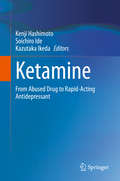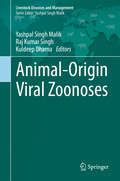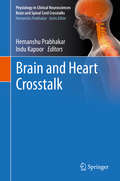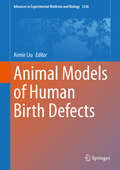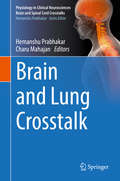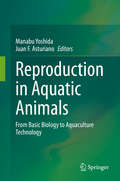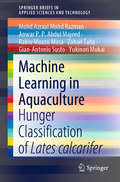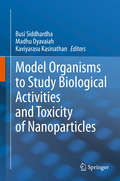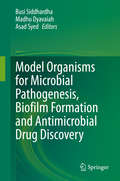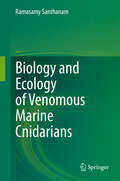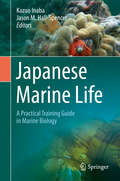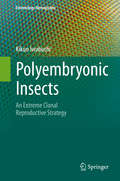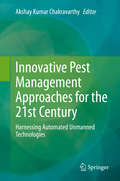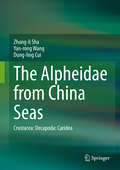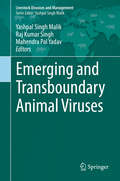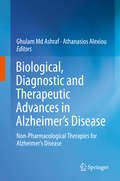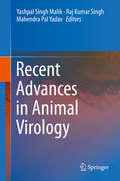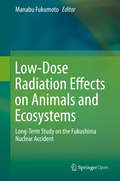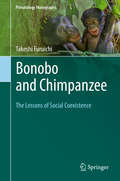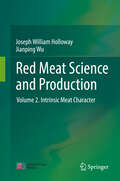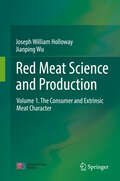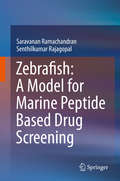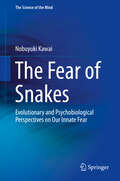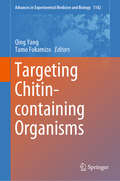- Table View
- List View
Insect Sex Pheromone Research and Beyond: From Molecules to Robots (Entomology Monographs)
by Yukio IshikawaThis book provides a complete overview of cutting-edge research on insect sex pheromones and pheromone communication systems. The coverage ranges from the chemistry, biosynthesis, and reception of sex pheromones to the control of odor-source searching behavior, and from molecules to the application of research findings to robotics. The book both summarizes the progress of studies conducted using Bombyx mori and several groups of moths and reviews sex pheromones of some non-lepidopteran insect groups of agricultural importance. Attention is drawn to recent findings on elaborate neural information processing in the brain in male moths and to the importance of olfactory receptors specifically tuned to sex pheromone molecules. Featuring contributions from leading experts on the topic, this book will be a unique and valuable resource for researchers and students in the fields of entomology, chemical ecology, insect physiology and biochemistry, evolution, biomimetics, and bioengineering. In addition to researchers, general insect lovers will find the book fascinating for its descriptions of the marvelous abilities of insects and the underlying mechanisms involved.
Ketamine: From Abused Drug to Rapid-Acting Antidepressant
by Kenji Hashimoto Soichiro Ide Kazutaka IkedaThis book presents the latest data from basic research and clinical trials supporting the effectiveness of ketamine as a treatment for depression, bipolar disorder, and suicidal behavior, setting these positive findings within the context of the serious problem of ketamine abuse. The first part of the book focuses on the evidence regarding ketamine abuse, with specific reference to Asian countries, and discusses countermeasures and complication management. It then addresses the mechanisms underlying the antidepressant and side effects of ketamine, which have remained elusive, describing and discussing important new research findings. Further, it explains insights gained from whole brain imaging in rodents and from behavioral pharmacology, and presents evidence regarding the role of gut microbiota, the NMDA receptor GluN2D subunit, and the lateral habenula in the actions of ketamine. These advances form the basis for the safer use of ketamine in patients with treatment-resistant depression and are expected to lead to the development of new antidepressants.
Animal-Origin Viral Zoonoses (Livestock Diseases and Management)
by Yashpal Singh Malik Raj Kumar Singh Kuldeep DhamaThis book is the second volume in the series Livestock Diseases and Management, and reviews the importance and implications of animal origin viral zoonoses. It also highlights the specific etiology and epidemiology of these viral infections and discusses their various biological and mechanical transmission mechanisms. Further, the book reviews various measures for controlling viral zoonoses and examines novel therapeutic and prophylactic strategies.Discussing recent studies on the pathogenesis and host immune response to these infections, it underscores the importance of using vaccines against these viral diseases to reduce the risk of them being transmitted to humans.Lastly, it describes in detail the challenges posed by these viral infections and our readiness to face them.
Brain and Heart Crosstalk (Physiology in Clinical Neurosciences – Brain and Spinal Cord Crosstalks)
by Hemanshu Prabhakar Indu KapoorThis book discusses the underlying mechanisms connecting the brain and heart. The physiology of the brain is such that it is easily affected by any altered physiology of other systems, which in turn may compromise cerebral blood flow and oxygenation. Together, the brain and heart control our body systems, allowing them to function automatically. This interaction between the brain and other systems makes it important for us to understand how any kind of injury to the brain can produce complications in remote organs or systems, such as the heart. The central nervous system is responsible for vegetative function and is central to homeostasis. Further, central nervous system responses are linked to the ongoing function of other organ systems e.g. feeding, thermoregulation, reproduction and muscle activity. It is therefore logical that neural control of the cardiovascular system must also interact with the neural control of other organ systems. This book explains in detail stressed cardiac conditions, discussing the pathophysiology and proposed treatment, and also describing lesser-known crosstalks between the acutely or chronically affected brain and heart.
Animal Models of Human Birth Defects (Advances in Experimental Medicine and Biology #1236)
by Aimin LiuThis book focuses on the use of animal models to study various human defects. It summarizes our current understanding of a variety of common human birth defects and the essential role of animal models in shedding light on the underlying mechanisms of these disorders. Birth defects are the leading cause of infant deaths, and cost billions of dollars in care for those affected. Unfortunately, the lack of a clear understanding of the mechanisms leading to many of these developmental disorders has hindered effective prevention and early intervention strategies. Studies using animal models have provided essential insights into several human birth defects. This book serves as a valuable reference resource for researchers and graduate students who are interested in learning the basic principles as well as the latest advances in the study of the mechanisms of human birth defects.
Brain and Lung Crosstalk (Physiology in Clinical Neurosciences – Brain and Spinal Cord Crosstalks)
by Hemanshu Prabhakar Charu MahajanThe central nervous system, which includes the brain and spinal cord, has a high metabolic demand. The physiology of the brain is such that it is easily affected by alterations in other systems, which in turn can compromise cerebral blood flow and oxygenation. Together the brain and spinal cord control the automatic function of our body systems. While other systems of body controls individual functions, central nervous system at the same time does many different functions, especially, controlling the function of other systems. This interaction between the brain and other systems is important when it comes to understanding how injuries to the brain can, at times, produce complications in remote organs or systems of the body, such as the lungs. This book explains the lesser-known crosstalks between acutely or chronically affected brain and lung, describing the pathophysiology of the lung following brain injury and discussing in detail the conflicts between the brain and lungs in relation to the tidal volumes, positive end-expiratory pressures, arterial carbon dioxide and oxygen levels, recruitment maneuvers and positioning, as well as potential therapeutic targets.
Reproduction in Aquatic Animals: From Basic Biology to Aquaculture Technology
by Manabu Yoshida Juan F. AsturianoThis book provides an up-to-date overview of the various reproductive systems of a variety of aquatic animals, from invertebrates to fishes. While all terrestrial animals use internal fertilization, aquatic animals have diverse reproductive systems. Some are internal fertilizers with or without mating, but many perform external fertilization. Because of this diversity, the reproductive systems of aquatic animals represent excellent models for the study of adaptive evolution and the species specificity of fertilization. In addition, many aquatic animals, including fish, crustaceans, and mollusks, are important as fishery and aquaculture resources. In this book, up-and-coming researchers examine reproductive systems in representative aquatic animals, covering both the basic knowledge and late-breaking results. Reproduction in Aquatic Animals: From Basic Biology to Aquaculture Technology will be of interest to graduate and postgraduate students in biology and agricultural sciences, as well as to researchers and technicians in the fields of reproductive biology and fishery science and to non-academics.
Machine Learning in Aquaculture: Hunger Classification of Lates calcarifer (SpringerBriefs in Applied Sciences and Technology)
by Zahari Taha Gian-Antonio Susto Yukinori Mukai Mohd Azraai Mohd Razman Anwar P. P. Abdul Majeed Rabiu Muazu MusaThis book highlights the fundamental association between aquaculture and engineering in classifying fish hunger behaviour by means of machine learning techniques. Understanding the underlying factors that affect fish growth is essential, since they have implications for higher productivity in fish farms. Computer vision and machine learning techniques make it possible to quantify the subjective perception of hunger behaviour and so allow food to be provided as necessary. The book analyses the conceptual framework of motion tracking, feeding schedule and prediction classifiers in order to classify the hunger state, and proposes a system comprising an automated feeder system, image-processing module, as well as machine learning classifiers. Furthermore, the system substitutes conventional, complex modelling techniques with a robust, artificial intelligence approach. The findings presented are of interest to researchers, fish farmers, and aquaculture technologist wanting to gain insights into the productivity of fish and fish behaviour.
Model Organisms to Study Biological Activities and Toxicity of Nanoparticles
by Busi Siddhardha Madhu Dyavaiah Kaviyarasu KasinathanThis book provides a comprehensive overview of state-of-the-art applications of nanotechnology in biology and medicine, as well as model organisms that can help us understand the biological activity and associated toxicity of nanoparticles, and devise strategies to minimize toxicity and enhance therapies. Thanks to their high surface-to-volume ratio, nanoparticles are characterized by excellent biocompatibility and bioavailability, a high therapeutic index, and relatively low toxicity, which has led to their widespread application in the early diagnosis of diseases, comprehensive monitoring of disease progression, and improved therapeutics. The book also explores nanoparticle-based insecticides and their mechanisms of action, and provides a comparative analysis of the various model organisms that are used to understand the biological properties of nanoparticles. Further, it describes various in-vivo models that yield important insights into nanomaterial-mediated toxicity, promoting the optimal utilization of nanoparticles. In closing, the book discusses future perspectives and regulatory issues concerning the use of nanomaterials in translational research.
Model Organisms for Microbial Pathogenesis, Biofilm Formation and Antimicrobial Drug Discovery
by Busi Siddhardha Madhu Dyavaiah Asad SyedThis book provides essential insights into microbial pathogenesis, host-pathogen interactions, and the anti-microbial drug resistance of various human pathogens on the basis of various model organisms. The initial sections of the book introduce readers to the mechanisms of microbial pathogenesis, host-pathogen interactions, anti-microbial drug resistance, and the dynamics of biofilm formation. Due to the emergence of various microbial resistant strains, it is especially important to understand the prognosis for microbial infections, disease progression profiles, and mechanisms of resistance to antibiotic therapy in order to develop novel therapeutic strategies. In turn, the second part of the book presents a comparative analysis of various animal models to help readers understand microbial pathogenesis, host-pathogen interactions, anti-microbial drug discovery, anti-biofilm therapeutics, and treatment regimes. Given its scope, the book represents a valuable asset for microbiologists, biotechnologists, medical professionals, drug development researchers, and pharmacologists alike.
Biology and Ecology of Venomous Marine Cnidarians
by Ramasamy SanthanamSeas and oceans cover 71 % of the earth’s surface and they are home to 80% of all life found on the planet . Among the different components of marine life, the phylum Cnidaria (formerly Coelenterata) has been reported to be responsible for more envenomations than any other marine phylum. It is believed that 2% of its known 11000 species are venomous to humans. Incidents caused by jellyfish are common all around the globe, with serious manifestations and occasional deaths reported in some countries. The Australian box jellyfish, Chironex fleckeri , has been reported to be very dangerous to humans, as contact with its tentacles can provoke immediate cardiovascular collapse and death within minutes. Though other volumes on venomous marine fauna are available, this is the first comprehensive book focusing on venomous marine cnidarians. It is a valuable text-cum-reference resource for researchers, teachers and students of various disciplines, including fisheries science, marine biotechnology and marine biology and for university and college libraries. It is also a useful guide for beachgoers, divers, physicians and environmentalists.
Japanese Marine Life: A Practical Training Guide in Marine Biology
by Kazuo Inaba Jason M. Hall-SpencerThis book gives an overview of the diverse marine fauna and flora of Japan and includes practical guides for investigating the biology and ecology of marine organisms. Introducing marine training courses offered at a range of Japanese universities, this is the first English textbook intended for marine biology instructors and students in Japan. It provides essential information on experimental procedures for the major areas of marine biology, including cell and developmental biology, physiology, ecology and environmental sciences, and as such is a valuable resource for those in Asian countries that share a similar flora and fauna. It also appeals to visitors interested in attending Japanese marine courses from countries around the world.
Polyembryonic Insects: An Extreme Clonal Reproductive Strategy (Entomology Monographs)
by Kikuo IwabuchiThis book provides an overview of our current understanding of polyembryony in insects. The study of polyembronic insects has advanced considerably over the last several decades.The book shows the exciting potential of polyembryonic insects and their impact on life sciences. It describes the mechanisms of polyembryogenesis; tissue-compatible invasion of the host, which is the first case of compatible cellular interaction between phylogenetically distant organisms without rejection; the sex differences in defense; and the environmental regulation of caste structure. The first book devoted to polyembryony in insects, it draws on the author’s research on polyembryonic wasps from 1990 to the present day, covering various topics such as polyembryogenesis in vitro, host-parasite interaction, sex differences in soldier function/humoral toxic factor, and the transcription analysis of polyembryogenesis.It is intended not only for researchers in the field of entomology, parasitology, ontogeny, reproductive biology, developmental biology, sociobiology, and evolutionary developmental biology (Evo-Devo), but also for postgraduate students in these fields.
Innovative Pest Management Approaches for the 21st Century: Harnessing Automated Unmanned Technologies
by Akshay Kumar ChakravarthySeveral Integrated Pest Management (IPM) approaches are available for managing pests of varied kinds, including individual and integrated methods for pest suppression. Recently the focus has shifted to pest management tools that act on insect systems selectively, are compatible with the environment, and are not harmful for ecosystems. Other approaches target specific biochemical and physiological aspects of insect metabolism, and involve biotechnological and genetic manipulation. Still other approaches include the use of nanotechnology, endophytes, optical and sonic manipulation to detect and control pest insects. Unfortunately, conventional forms of pest management do not focus on technology transfer to the ground level workers and farmers. As a result, farmers are incurring huge losses of crops and revenues. This book highlights the importance of using communication tools in pest management and demonstrates some success stories of utilizing automated unmanned technologies in this context. The content is divided into three sections, the first of which, “Pest Population Monitoring: Modern Tools,” covers long and short-range pest population monitoring techniques and tools such as satellites, unmanned aerial vehicles/drones, remote sensing, digital tools like GIS, GPS for mapping, lidar, mobile apps, software systems, artificial diet designs and functional diversity of info-chemicals. The second section of the book is devoted to “Emerging Areas in Pest Management” and offers a glimpse of diversified tactics that have been developed to contain and suppress pest populations such as endophytes, insect vectors of phytoplasma, Hymenopterans parasitoids, mass production and utilization of NPV etc. In turn, the third section focuses on “Integrated Pest Management” and presents farming situations that illustrate how research in diversified aspects has helped to find solutions to specific pest problems, and how some new and evolving tactics can be practically implemented. Given its scope, the book offers a valuable asset for entomology and plant pathology researchers, students of zoology and plant protection, and readers whose work involves agriculture, horticulture, forestry and other ecosystems.
The Alpheidae from China Seas: Crustacea: Decapoda: Caridea
by Zhong-li Sha Yan-rong Wang Dong-ling CuiAs one of the largest families within the Caridea, the Alpheidae have attracted much attention for its species richness, especially on coral reefs. The Alpheidae are one of the most abundant decapods in tropical and subtropical areas, with 48 genera and more than 700 known species. The Alpheidae present a particular challenge in terms of both taxonomy and systematics as they are difficult to identify (some species vary in their growth and there are often large differences between the sexes). Traditional, morphology-based research on the Alpheidae still plays an important role in identifying species, compared with new methods, such as the short gene sequences. Based on more than 2000 specimens collected from the China Seas, this book describes and clearly illustrates 146 species belonging to 16 genera of the Alpheidae. It also presents the key features of every genus and every species within every genus, to enable readers to easily identify the alphid shrimps of the China Seas.
Emerging and Transboundary Animal Viruses (Livestock Diseases and Management)
by Yashpal Singh Malik Raj Kumar Singh Mahendra Pal YadavThis book, which is the first volume of the book series-Livestock Diseases and Management, summarizes the prominence and implications of the emerging and transboundary animal viruses. Although the livestock plays an important role in the economy of many countries, the emerging and transboundary animal viral diseases possess a serious risk to the animal-agriculture sector and food security globally. The book describes the precise and up-to-date information on animal viral diseases which have emerged in the recent past or are re-emerging due to various environmental factors and those which are not bounded in restricted national boundaries and attained the transboundary status. The chapters summarize the recent advancements in the molecular state-of-art tools towards the development of diagnostics, prophylactics, and therapeutics of these viruses. It also explicitly describes the challenges imposed by the emerging and transboundary viral infections and our preparedness to counter them.
Biological, Diagnostic and Therapeutic Advances in Alzheimer's Disease: Non-Pharmacological Therapies for Alzheimer's Disease
by Ghulam Md Ashraf Athanasios AlexiouThis book discusses the latest research into the highly prevalent neurodevelopmental disease most commonly associated with aging: Alzheimer’s disease (AD). Even after years of research, Alzheimer’s disease is still far from being cured. It presents a range of common symptoms in the form of behavioral and cognitive impairments. This book describes the symptoms and the biology behind them. The contents covers latest findings on the genetics involved and various factors and pathways influencing disease development. It also covers various non-pharmacological therapies like immunotherapy, use of natural products, and employing nanotechnology in both the detection and treatment of AD. This book also highlights the role of diet and nutrition in healthy aging. Given its scope, it offers a valuable asset for researchers and clinicians alike.
Recent Advances in Animal Virology
by Yashpal Singh Malik Raj Kumar Singh Mahendra Pal YadavThis book discusses the prominence and implication of the viral diseases that are a major threat to animals around the globe. A number of these diseases have also shown links with human populations, which has implications for public health. This book offers detailed and up-to-date information on viral diseases in livestock and poultry that were and/or are still a problem. Including cutting-edge developments, it also highlights several landmark contributions in the field of virology from India. Additionally, the book features tables and figures showing important clinical data and recommendations, with references for further information. It also explores the economic impact of viral diseases for farmers and the livestock industry, providing several examples. Further, it presents the latest information on viral diseases in global context, with a focus on state-of-art, molecular tools for the development of diagnostics, prophylactics and therapeutics. Lastly, the book also describes the challenges posed by the emerging and transboundary viral infections and our preparedness to counter them.
Low-Dose Radiation Effects on Animals and Ecosystems: Long-Term Study on the Fukushima Nuclear Accident
by Manabu FukumotoThis open access book summarizes the latest scientific findings regarding the biological effects of the Fukushima Daiichi Nuclear Power Plant (FNPP) accident in 2011.Various cases of changes in animals and organisms have been reported since the FNPP accident. However, it is often unknown whether they are actually due to radiation, since the dose or dose-rate are not necessarily associated with the changes observed. This book brings together the works of radiation biologists and ecologists to provide reliable radioecology data and gives insight into future radioprotection.The book examines the environmental pollution and radiation exposure, and contains valuable data from abandoned livestock in the ex-evacuation zone and from wild animals including invertebrates and vertebrates, aqueous and terrestrial animals, and plants that are subjected to long-term exposure in the area still affected by radiation. It also analyzes dose evaluation, and offers new perspectives gained from the accident, as well as an overview for future studies to promote radioprotection of humans and the ecosystem.Since the biological impact of radiation is influenced by various factors, it is difficult to scientifically define the effects of low-dose/low-dose-rate radiation. However, the detailed research data presented can be combined with the latest scientific and technological advances, such as artificial intelligence, to provide new insights in the future.This book is a unique and valuable resource for researchers, professionals and anyone interested in the impact of exposure to radiation or contamination with radioactive materials.
Bonobo and Chimpanzee: The Lessons of Social Coexistence (Primatology Monographs)
by Takeshi FuruichiThis book describes the similarities and differences between two species, bonobos and chimpanzees, based on the three decades the author has spent studying them in the wild, and shows how the contrasting nature of these two species is also reflected in human nature. The most important differences between bonobos and chimpanzees, our closest relatives, are the social mechanisms of coexistence in group life. Chimpanzees are known as a fairly despotic species in which the males exclusively dominate over the females, and maintain a rigid hierarchy. Chimpanzees have developed social intelligence to survive severe competition among males: by upholding the hierarchy of dominance, they can usually preserve peaceful relations among group members. In contrast, female bonobos have the same or even a higher social status than males. By evolving pseudo-estrus during their non-reproductive period, females have succeeded in moderating inter-male sexual competition, and in initiating mate selection. Although they are non-related in male-philopatric society, they usually aggregate in a group, enjoy priority access to food, determine which male is the alpha male, and generally maintain much more peaceful social relations compared to chimpanzees. Lastly, by identifying key mechanisms of social coexistence in these two species, the author also seeks to find solutions or “hope” for the peaceful coexistence of human beings."Takeshi Furuichi is one of very few scientists in the world familiar with both chimpanzees and bonobos. In lively prose, reflecting personal experience with apes in the rain forest, he compares our two closest relatives and explains the striking differences between the male- dominated and territorial chimpanzees and the female-centered gentle bonobos."Frans de Waal, author of Mama’s Last Hug - Animal Emotions and What They Tell Us about Ourselves (Norton, 2019)
Red Meat Science and Production: Volume 2. Intrinsic Meat Character
by Joseph William Holloway Jianping WuThis book comprehensively describes the biological underpinnings of red meat production, discussing the current state of the science in the context of the provision of red meat products perceived by consumers to offer a quality eating experience. Covering advances in the science of red meat production, it focuses on production system elements that affect product quality. The chapters explore the latest developments in the determination of consumer preferences, and interpret of these preferences in terms of quality characteristics of red meat, investigating the science-based orchestration of red meat production to achieve product consistency. The book highlights topics such as consumer preferences, the biological and production system elements affecting red meat safety, and the intrinsic (appearance, aroma, and sensory quality) and extrinsic (humane animal and environmentally friendly production) characteristics of red meat. For each characteristic, it discusses the underlying biological and biochemical processes and examines means of altering production systems to impact consumer eating experiences. The book also features a perspective on creating holistic integrated systems for producing red meats to meet consumers’ expectations around the globe. Written by leading authorities in the area of global red meat production systems, it is a comprehensive resource for consumer-oriented red meat producers.
Red Meat Science and Production: Volume 1. The Consumer and Extrinsic Meat Character
by Joseph William Holloway Jianping WuThis book comprehensively describes the biological underpinnings of red meat production, discussing the current state of the science in the context of the provision of red meat products perceived by consumers to offer a quality eating experience. Covering advances in the science of red meat production, it focuses on production system elements that affect product quality. The chapters explore the latest developments in the determination of consumer preferences, and interpret of these preferences in terms of quality characteristics of red meat, investigating the science-based orchestration of red meat production to achieve product consistency. The book highlights topics such as consumer preferences, the biological and production system elements affecting red meat safety, and the intrinsic (appearance, aroma, and sensory quality) and extrinsic (humane animal and environmentally friendly production) characteristics of red meat. For each characteristic, it discusses the underlying biological and biochemical processes and examines means of altering production systems to impact consumer eating experiences. The book also features a perspective on creating holistic integrated systems for producing red meats to meet consumers’ expectations around the globe. Written by leading authorities in the area of global red meat production systems, it is a comprehensive resource for consumer-oriented red meat producers.
Zebrafish: A Model for Marine Peptide Based Drug Screening
by Saravanan Ramachandran Senthilkumar RajagopalThis book offers a comprehensive overview of toxicology, highlighting the significance of peptide-based toxins from marine environments. It discusses the principles of protein-carbohydrate and domain-domain interactions to increase our understanding of toxicology in zebrafish models, as well as drug interaction mechanisms and target definition in drug discovery. It also reviews the structure of marine peptides/toxins and the toxicology of peptide secreting cells and cells that respond to these enzymes, and describes the normal and abnormal toxicology of marine peptides in zebrafish models. Offering insights into the field of proteomics, particularly current practice and research models for solving its many riddles, the book also explains the analytical principles of marine protein-protein and protein-carbohydrate interaction in the context of teratogenicity in target identification in peptide- based drug discovery. Lastly, the book methodically examines the preclinical research on marine proteins/peptides.
The Fear of Snakes: Evolutionary and Psychobiological Perspectives on Our Innate Fear (The Science of the Mind)
by Nobuyuki KawaiThis book provides a series of compelling evidence that shows that humans have innate fear of snakes. Building on the previous studies on the Snake Detection Theory (SDT), the author presents a summary of psychological and neuropsychological experiments to explain the fear of snakes in humans and primates. Readers will come to understand why and how we are afraid of snakes from an evolutionary perspective.The first half of the book discusses the history of psychological behaviorism and neobehaviorism. The latter half of the book consists mainly of the experimental studies performed by the author with a focus on three key items: First, compared with other animals, snakes especially draw the attention of primates and humans. Second, the ability of primates and humans to recognize snakes with particular efficiency. Third, processing mechanisms within the brain for snake detection is discussed from a new viewpoint.The book offers a unique resource for all primatologists, psychologists, neuroscientists, anthropologists, herpetologists, and biologists who are interested in the evolution of visual and cognitive systems, mechanisms of fear, snakes or primates.
Targeting Chitin-containing Organisms (Advances in Experimental Medicine and Biology #1142)
by Qing Yang Tamo FukamizoThis book provides a comprehensive overview of chitin biology and chitin metabolism related enzymes. Chitin, the second most abundant biopolymer in nature after to cellulose, is a linear biopolymer composed of β-1,4-linked N-acetylglucosamine (GlcNAc), and an essential component in the exoskeletons of insects, mites, ticks and crustaceans, the egg shells of parasitic nematodes, and fungal cell walls. Although some chitin-containing organisms are a threat to human health, food safety and agricultural production, non-chitin containing organisms like humans, mammals and plants have an innate immune response to these hazardous organisms. The book provides researchers and students with information on the recent research advances concerning the biology of chitin-containing organisms as well as cross-talks between chitin-containing and non-chitin-containing organisms. Highlighting chitin remodeling enzymes and inhibitors, it also offers drug developers essential insights into designing specific molecules for the control of hazardous chitin-containing organisms.
